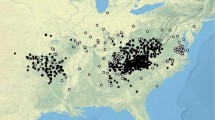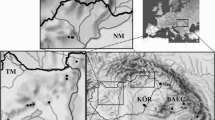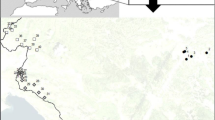Abstract
Parides ascanius (Lepidoptera: Papilionidae) is a butterfly endemic to the sand forests (“restingas”) of one of the most populated areas of Brazil (from Rio de Janeiro state to South Espírito Santo state), and was the first invertebrate officially recognized as being threatened in Brazil. Here we present a panel of eight polymorphic microsatellite loci and partial sequences of mitochondrial gene COI aiming to characterize this butterfly’s genetic diversity and understand its distribution among the extant populations. We estimate FST metrics, migration rates, cluster assignment, and spatial structure of genetic diversity. FST and statistics indicate low genetic structure and no evidence for endogamy, with all populations connected by high migration rates. Seven populations have low permanence rates (68–75 %) with increased migration probabilities for all populations. One population displays higher permanence rate (87.7 %), as the metropolitan matrix isolates it. Spatial analysis shows a global structure around the city of Rio de Janeiro and the Guanabara Bay; assignment analysis recovers six clusters evenly spread among sampled populations. These findings are consistent with a natural scenario of metapopulation dynamics for P. ascanius, with low genetic diversity and no endogamy, but progressively isolated by the metropolitan matrix. Conservation efforts should focus in connecting the isolated population, broaden the searches for new populations, and preserve all extant habitat patches where P. ascanius still occurs.






Similar content being viewed by others
References
Allendorf FW, Luikart G (2007) Conservation and the genetics of populations. Blackwell Publishing, Oxford
Billotte N, Lagoda PJL, Risterucci AM, Baurens FC (1999) Microsatellite-enriched libraries: applied methodology for the development of SSR markers in tropical crops. Fruits 54:277–288
Bogdanowicz SM, Wallner WE, Bell J et al (1993) Asian gypsy moths (Lepidoptera: Lymantriidae) in North America: evidence from molecular data. Ann Entomol Soc Am 86:710–715. doi:10.1093/aesa/86.6.710
Brown KS Jr, Brown GG (1992) Habitat alteration and species loss in Brazilian forests. In: Whitmore TC, Sayer JA (eds) Tropical deforestation and species extinction. Boom Koninklijke Uitgevers, Barneveld
Brown KS Jr, Freitas AVL (2002) Butterfly communities of urban forest fragments in Campinas, São Paulo, Brazil: structure, instability, environmental correlates, and conservation. J Insect Conserv 6:217–231. doi:10.1023/A:1024462523826
Brown KSJ, Damman AJ, Feeny P (1981) Troidine swallowtails (Lepidoptera: Papilionidae) in southeastern Brazil: natural history and foodplant relationships. J Res Lepid 19:199–226
Clement M, Posada D, Crandall KA (2000) TCS: a computer program to estimate gene genealogies. Mol Ecol 9:1657–1659
Dewoody J, Nason JD, Hipkins VD (2006) Mitigating scoring errors in microsatellite data from wild populations. Mol Ecol Notes 6:951–957. doi:10.1111/j.1471-8286.2006.01449.x
Earl DA, vonHoldt BM (2011) STRUCTURE HARVESTER: a website and program for visualizing STRUCTURE output and implementing the Evanno method. Conserv Genet Resour 4:359–361. doi:10.1007/s12686-011-9548-7
Evanno G, Regnaut S, Goudet J (2005) Detecting the number of clusters of individuals using the software structure: a simulation study. Mol Ecol 14:2611–2620. doi:10.1111/j.1365-294X.2005.02553.x
Excoffier L, Lischer HEL (2010) Arlequin suite ver 3.5: a new series of programs to perform population genetics analyses under Linux and Windows. Mol Ecol Resour 10:564–567. doi:10.1111/j.1755-0998.2010.02847.x
Excoffier L, Smouse PE, Quattro JM (1992) Analysis of molecular variance inferred from metric distances among dna haplotypes—application to human mitochondrial-dna restriction data. Genetics 131:479–491
Folmer O, Black M, Hoeh W et al (1994) DNA primers for amplification of mitochondrial cytochrome c oxidase subunit I from diverse metazoan invertebrates. Mol Mar Biol Biotechnol 3:294–299
Freitas A, Marini-Filho O. J (2011) Plano de açao nacional para conservaçao dos lepidópteros ameaçados de extinçao. Instituto Chico Mendes de Conservação da Biodiversidade
Freitas AVL, Ramos RR (2001) Population biology of Parides anchises nephalion (Papilionidae) in a coastal site in Southeast Brazil. Braz J Biol 61:623–630. doi:10.1590/S1519-69842001000400011
Gimenez Dixon M (1996) The IUCN red list of threatened species. IUCN, Gland
Goudet J (2005) hierfstat, a package for r to compute and test hierarchical F-statistics. Mol Ecol Notes 5:184–186. doi:10.1111/j.1471-8286.2004.00828.x
Habel JC, Schmitt T, Meyer M et al (2010) Biogeography meets conservation: the genetic structure of the endangered lycaenid butterfly Lycaena helle (Denis & Schiffermüller, 1775). Biol J Linn Soc 101:155–168. doi:10.1111/j.1095-8312.2010.01471.x
Herkenhoff EV, Monteiro RF, Esperanço AP (2013) Population biology of the endangered fluminense swallowtail butterfly Parides ascanius (Papilionidae: Papilioninae: Troidini). J Lepid Soc 67:29–34
Jakobsson M, Rosenberg NA (2007) CLUMPP: a cluster matching and permutation program for dealing with label switching and multimodality in analysis of population structure. Bioinformatics 23:1801–1806. doi:10.1093/bioinformatics/btm233
Jarne P, Lagoda PJ (1996) Microsatellites, from molecules to populations and back. Trends Ecol Evol 11:424–429
Jombart T (2008) adegenet: a R package for the multivariate analysis of genetic markers. Bioinformatics 24:1403–1405. doi:10.1093/bioinformatics/btn129
Jombart T, Devillard S, Dufour A-B, Pontier D (2008) Revealing cryptic spatial patterns in genetic variability by a new multivariate method. Heredity (Edinb) 101:92–103. doi:10.1038/hdy.2008.34
Jombart T, Devillard S, Balloux F (2010) Discriminant analysis of principal components: a new method for the analysis of genetically structured populations. BMC Genet 11:94. doi:10.1186/1471-2156-11-94
Kearse M, Moir R, Wilson A et al (2012) Geneious basic: an integrated and extendable desktop software platform for the organization and analysis of sequence data. Bioinformatics 28:1647–1649. doi:10.1093/bioinformatics/bts199
Leal CG, de Gusmão Câmara I (2003) The Atlantic Forest of South America: biodiversity status, threats, and outlook. Island Press, Washington, DC
Marques MCM, Swaine MD, Liebsch D (2011) Diversity distribution and floristic differentiation of the coastal lowland vegetation: implications for the conservation of the Brazilian Atlantic Forest. Biodivers Conserv 20:153–168. doi:10.1007/s10531-010-9952-4
Meglécz E, Solignac M (1998) Microsatellite Loci for Parnassius mnemosyne (Lepidoptera). Hereditas 128:179–180. doi:10.1111/j.1601-5223.1998.00179.x
Meglécz E, Petenian F, Danchin E et al (2004) High similarity between flanking regions of different microsatellites detected within each of two species of Lepidoptera: Parnassius apollo and Euphydryas aurinia. Mol Ecol 13:1693–1700. doi:10.1111/j.1365-294X.2004.02163.x
Moran P (1948) The interpretation of statistical maps. J Roy Stat Soc B 10:243–251
Moran PAP (1950) Notes on continuous stochastic phenomena. Biometrika 37:17–23. doi:10.1093/biomet/37.1-2.17
Nei M (1987) Molecular evolutionary genetics. Columbia University Press
Otero LS, Brown KS Jr (1986) Biology and ecology of Parides ascanius (Cramer, 1775) (Lep., Papilionidae), a primitive butterfly threatened with extinction. Atala 10–12:2–16
Peakall R, Smouse PE (2012) GenAlEx 6.5: genetic analysis in Excel. Population genetic software for teaching and research–an update. Bioinformatics 28:2537–2539. doi:10.1093/bioinformatics/bts460
Plummer M, Best N, Cowles K, Vines K (2006) CODA: convergence diagnosis and output analysis for MCMC. R News 6:7–11
Pritchard JK, Stephens M, Donnelly P (2000) Inference of population structure using multilocus genotype data. Genetics 155:945–959
Pritchard JK, Wen X, Falush D (2010) Documentation for structure software: Version 2.3
R Core Team (2014) R: a language and environment for statistical computing. Vienna, Austria: R Foundation for Statistical Computing. Available at http://cran.r-project.org
Rambaut A, Suchard MA, Xie W, Drummond A (2014) Tracer, v1.6
Raymond M, Rousset F (1995) GENEPOP (Version 1.2): population genetics software for exact tests and ecumenicism. J Hered 86:248–249
Ribeiro DB, Freitas AVL (2014) Brazil’s new laws bug collectors. Science 345:1571. doi:10.1126/science
Ribeiro MC, Metzger JP, Martensen AC et al (2009) The Brazilian Atlantic Forest: how much is left, and how is the remaining forest distributed? Implications for conservation. Biol Conserv 142:1141–1153. doi:10.1016/j.biocon.2009.02.021
Rocha CFD, Bergallo HG, Van Sluys M et al (2007) The remnants of restinga habitats in the brazilian Atlantic Forest of Rio de Janeiro state, Brazil: habitat loss and risk of disappearance. Braz J Biol 67:263–273
Rosenberg NA (2004) distruct: a program for the graphical display of population structure. Mol Ecol Notes 4:137–138. doi:10.1046/j.1471-8286.2003.00566.x
Rousset F (2008) genepop’007: a complete re-implementation of the genepop software for Windows and Linux. Mol Ecol Resour 8:103–106. doi:10.1111/j.1471-8286.2007.01931.x
Schoville SD, Lam AW, Roderick GK (2012) A range-wide genetic bottleneck overwhelms contemporary landscape factors and local abundance in shaping genetic patterns of an alpine butterfly (Lepidoptera: Pieridae: Colias behrii). Mol Ecol 21:4242–4256. doi:10.1111/j.1365-294X.2012.05696.x
Sielezniew M, Rutkowski R (2011) Population isolation rather than ecological variation explains the genetic structure of endangered myrmecophilous butterfly Phengaris (=Maculinea) arion. J Insect Conserv 16:39–50. doi:10.1007/s10841-011-9392-9
Sinama M, Dubut V, Costedoat C, Gilles A (2011) Challenges of microsatellite development in Lepidoptera: Euphydryas aurinia (Nymphalidae) as a case study. Eur J Entomol 108:261–266
Soares A, Bizarro J, Bastos CB (2011) Preliminary analysis of the diurnal Lepidoptera fauna of the Três Picos State Park, Rio de Janeiro, Brazil, with a note on Parides ascanius (Cramer, 1775). Trop Lepid Res 21:66–79
Tay W, Behere GT, Batterham P, Heckel DG (2010) Generation of microsatellite repeat families by RTE retrotransposons in lepidopteran genomes. BMC Evol Biol 10:144–146. doi:10.1186/1471-2148-10-144
Tyler HA, Brown KS, Wilson KH (1994) Swallowtail butterflies of the Americas: a study in biological dynam- ics, ecological diversity, biosystematics, and conservation. ScientiÞc Publishers, Gainesville
Uehara-Prado M, Fonseca RL (2007) Urbanization and mismatch with protected areas place the conservation of a threatened species at risk. Biotropica 39:264–268. doi:10.1111/j.1744-7429.2006.00260.x
Ugelvig LV, Andersen A, Boomsma JJ, Nash DR (2012) Dispersal and gene flow in the rare, parasitic Large Blue butterfly Maculinea arion. Mol Ecol 21:3224–3236. doi:10.1111/j.1365-294X.2012.05592.x
Untergasser A, Nijveen H, Rao X et al (2007) Primer3Plus, an enhanced web interface to Primer3. Nucleic Acids Res 35:W71–W74. doi:10.1093/nar/gkm306
van Oosterhout C, Hutchinson WF, Wills DPM, Shipley P (2004) micro-checker: software for identifying and correcting genotyping errors in microsatellite data. Mol Ecol Notes 4:535–538. doi:10.1111/j.1471-8286.2004.00684.x
Weir BS (1996) Genetic data analysis II: methods for discrete population genetic data (Sinauer. Massachusetts, Sunderland
Weir BS, Cockerham CC (1984) Estimating F-statistics for the analysis of population-structure. Evolution 38:1358–1370. doi:10.2307/2408641
Whitlock MC (2004) Selection and drift in metapopulations. In: Hanski I, Gaggiotti OE (eds) Ecology, genetics, and evolution of metapopulations. Academic Press, San Diego, pp 153–173
Wilson GA, Rannala B (2003) Bayesian inference of recent migration rates using multilocus genotypes. Genetics 163:1177–1191
Zhang D-X (2004) Lepidopteran microsatellite DNA: redundant but promising. Trends Ecol Evol 19:507–509. doi:10.1016/j.tree.2004.07.020
Acknowledgments
The authors would like to thank Juan Pablo Torres Florez and Leila Shirai for contributions to the manuscript. NS thanks CNPq scholarship (141254/2013-0) and CAPES (3700/14-3), RFM thanks CNPq, CAPES, FAPESP, INCT, HYMPAR SUDESTE, FAPERJ and Instituto Chico Mendes-ICMBio (38024-3), GSSA thanks Secretaria do Meio Ambiente do Rio de Janeiro, Ministério do Meio Ambiente do Brasil, and the Brazilian Army for authorization for sampling, APS thanks FAPESP (2008/52197-4) and CNPq, AVLF thanks BIOTA/FAPESP (2011/50225-3), CNPq (302585/2011-7) and the National Science Foundation (DEB-1256742). This publication is part of the RedeLep “Rede Nacional de Pesquisa e Conservação de Lepidópteros” SISBIOTA-Brasil/CNPq (563332/2010-7).
Funding
Seraphim, N: Conselho Nacional de Desenvolvimento Científico e Tecnológico, Brazil, Grant Number 141254/2013-0; and Coordenação de Aperfeiçoamento de Pessoal de Nível Superior, Brazil, Grant Number 3700/14-3. Souza, AP: Fundação de Amparo à Pesquisa do Estado de São Paulo, Brazil, Grant Number: 2008/52197-4. Freitas, AVL: Fundação de Amparo à Pesquisa do Estado de São Paulo, Brazil, Grant from BIOTA/FAPESP Number 2011/50225-3.
Author information
Authors and Affiliations
Corresponding author
Electronic supplementary material
Below is the link to the electronic supplementary material.
Rights and permissions
About this article
Cite this article
Seraphim, N., Barreto, M.A., Almeida, G.S.S. et al. Genetic diversity of Parides ascanius (Lepidoptera: Papilionidae: Troidini): implications for the conservation of Brazil’s most iconic endangered invertebrate species. Conserv Genet 17, 533–546 (2016). https://doi.org/10.1007/s10592-015-0802-5
Received:
Accepted:
Published:
Issue Date:
DOI: https://doi.org/10.1007/s10592-015-0802-5




